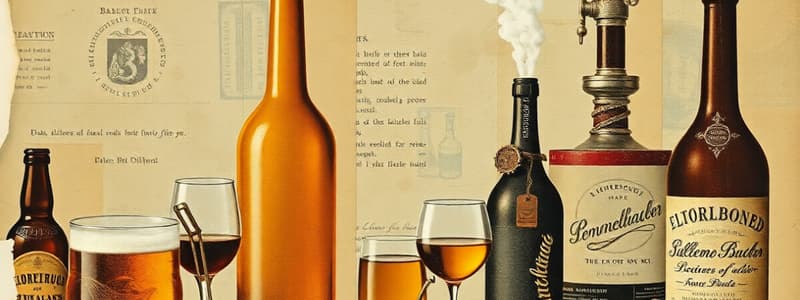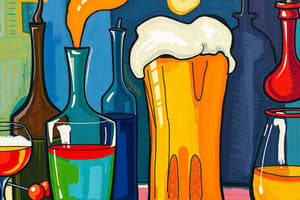Podcast
Questions and Answers
What is the primary function of a still in the distillation process?
What is the primary function of a still in the distillation process?
- To convert vapor back into a liquid (correct)
- To enhance the flavor of the spirit
- To filter impurities from the wine
- To collect the original wash
Which component of the still is responsible for cooling the vapor?
Which component of the still is responsible for cooling the vapor?
- The condenser (correct)
- The receiver
- The original container
- The wash
What temperature does ethanol boil at during the distillation process?
What temperature does ethanol boil at during the distillation process?
- 95.5°C
- 85°C
- 100°C
- 78.5°C (correct)
What are the three parts of the distillate produced during distillation called?
What are the three parts of the distillate produced during distillation called?
What is a significant drawback of using a pot still?
What is a significant drawback of using a pot still?
What material is considered best for constructing a pot still?
What material is considered best for constructing a pot still?
What is the main advantage of using a pot still for distillation?
What is the main advantage of using a pot still for distillation?
What distinguishes a patent still from a pot still?
What distinguishes a patent still from a pot still?
What is the primary function of the 'analyzer' column in the patent still?
What is the primary function of the 'analyzer' column in the patent still?
Which of the following describes a drawback of using a patent still?
Which of the following describes a drawback of using a patent still?
How is the Gay Lussac system of proof measurement defined?
How is the Gay Lussac system of proof measurement defined?
What is the equivalent proof for 100% alcohol under the American proof scale?
What is the equivalent proof for 100% alcohol under the American proof scale?
What is required to be indicated on liquor bottles by manufacturers?
What is required to be indicated on liquor bottles by manufacturers?
What method was used historically to check the alcoholic strength of a beverage?
What method was used historically to check the alcoholic strength of a beverage?
Which proof scale uses a correspondence of 100⁰ GL = 175⁰ BP = 200⁰ US?
Which proof scale uses a correspondence of 100⁰ GL = 175⁰ BP = 200⁰ US?
What kind of spirits does the patent still primarily produce?
What kind of spirits does the patent still primarily produce?
What is the definition of an alcoholic beverage?
What is the definition of an alcoholic beverage?
Which fermentation process is responsible for converting sugar into alcohol?
Which fermentation process is responsible for converting sugar into alcohol?
What is true about methyl alcohol?
What is true about methyl alcohol?
What are the two types of distillation processes mentioned?
What are the two types of distillation processes mentioned?
What temperature does alcohol evaporate compared to water?
What temperature does alcohol evaporate compared to water?
Which historical period is associated with the first distillation of wine?
Which historical period is associated with the first distillation of wine?
What is not a characteristic of pure alcohol?
What is not a characteristic of pure alcohol?
What is the main purpose of distillation in the production of alcoholic beverages?
What is the main purpose of distillation in the production of alcoholic beverages?
Flashcards are hidden until you start studying
Study Notes
Alcoholic Beverages
- Any liquid containing 0.5% to 95% ethyl alcohol by volume is considered an alcoholic beverage.
- Ethyl alcohol is the type found in alcoholic beverages, while methyl alcohol is fatal and used industrially.
- Alcoholic beverages are produced by fermentation of sugar-based foods or distillation of fermented products.
Fermentation
- Sugar in fruits or grains is converted to alcohol by yeast.
- The chemical equation for fermentation is: C6H12O6 + YEAST = 2C2H5OH + 2CO2 (Sugar + Yeast = Alcohol + Carbon Dioxide)
Distillation
- Fermented mash is heated, causing alcohol to evaporate at a lower temperature than water (78.5°C).
- The evaporated alcohol is then cooled and condensed back into a liquid.
- There are two main distillation methods: Pot Still and Patent Still.
Pot Still Method
- Also known as batch distillation.
- Traditional method using an enclosed kettle that heats the mash and collects the evaporated alcohol.
- Copper is preferred for the still due to its ability to remove impurities.
- Produces spirits in batches, requiring loading, boiling, cleaning, and reloading after each run.
Advantages of Pot Still
- The Pot Still method is a traditional batch distillation using copper, producing higher alcohol content spirits via fermentation. It separates elements to enhance flavors and remove impurities, yielding products like whiskey, rum, and gin, significant in cultural practices globally.
- that highlight the unique characteristics and flavors of ingredients, creating an artisanal product..
- This method focuses on enhancing the volatile compounds that contribute to a rich, aromatic profile.
- This results in a fuller mouthfeel, contributing to a more satisfying drinking experience.
- Allows distillation of small quantities of mash.
Disadvantages of Pot Still
- Requires more time and labor.
- Costly to operate.
- Requires frequent cleaning and refilling.
Patent Still Method
- Also known as Coffey Still, continuous distillation, or columnar distillation.
- Invented in the late 1830s, allows continuous production of spirit as long as mash is added.
- Uses two columns: analyzer and rectifier.
- Analyzer vaporizes alcohol from the hot mash, while rectifier cools the vapors, purifying and condensing them.
- Produces lighter-bodied spirits.
Advantages of Patent Still
- Less labor-intensive, requires minimal cleaning and refilling.
- Produces larger quantities compared to Pot Still.
- Cost-effective.
Disadvantages of Patent Still
- Not suitable for distilling small quantities of spirits.
- May not achieve the desired aroma and essential elements found in drinks.
Alcohol Content / Proof
- Proof indicates the alcoholic strength of different beverages.
- Originally, proof was determined by adding gunpowder to the liquid and observing its flammability.
- If the mixture exploded, it was "over proof," if it fizzed, it was "under proof," and if it burned with a steady blue flame, it was "proved" to be about 50% alcohol.
Scales For Measuring Alcohol Strength
-
Gay Lussac (GL) system: Proof equals the percentage of alcohol in the spirit. Example: 43% alcohol = 43⁰ GL.
-
British or Canadian Proof (BP): 57.1% alcohol is equivalent to 100⁰ BP, and 100% alcohol is equal to 175⁰ BP.
-
American or US Proof: 50% alcohol is equal to 100⁰ US, and 100% alcohol is equal to 200⁰ US.
-
Equivalence: 100⁰ GL = 175⁰ BP = 200⁰ US.
-
OIML (Organization International Metrologies Legale): Currently, all manufacturers must indicate the alcohol content as a percentage on bottles.
Studying That Suits You
Use AI to generate personalized quizzes and flashcards to suit your learning preferences.




